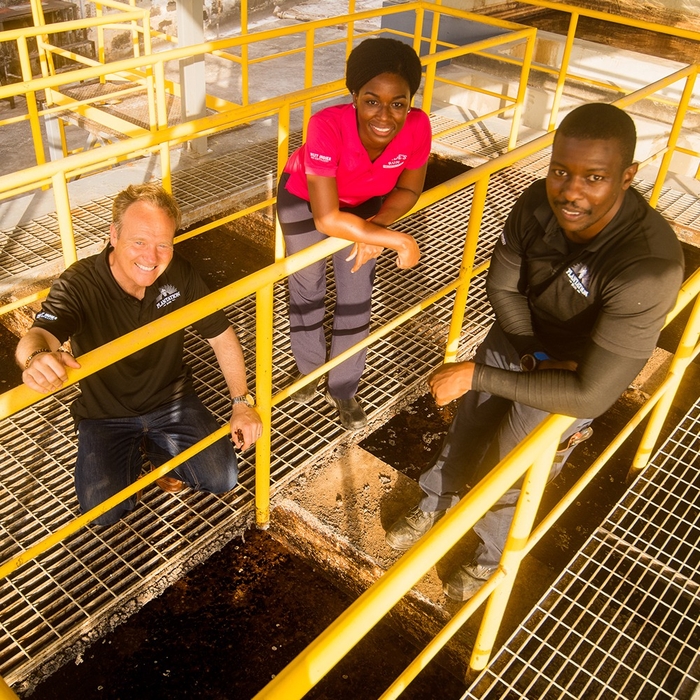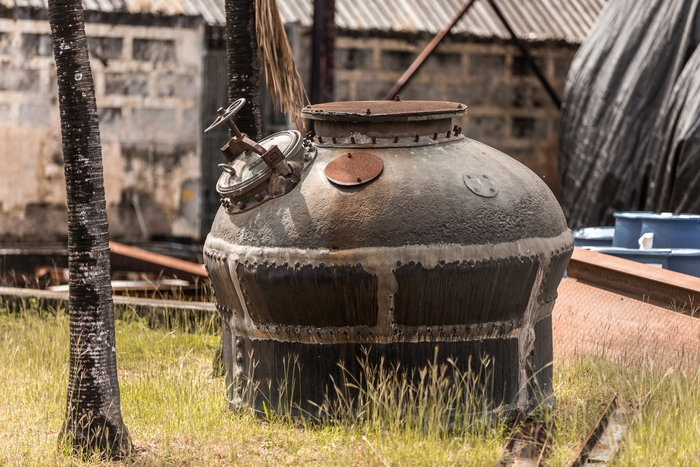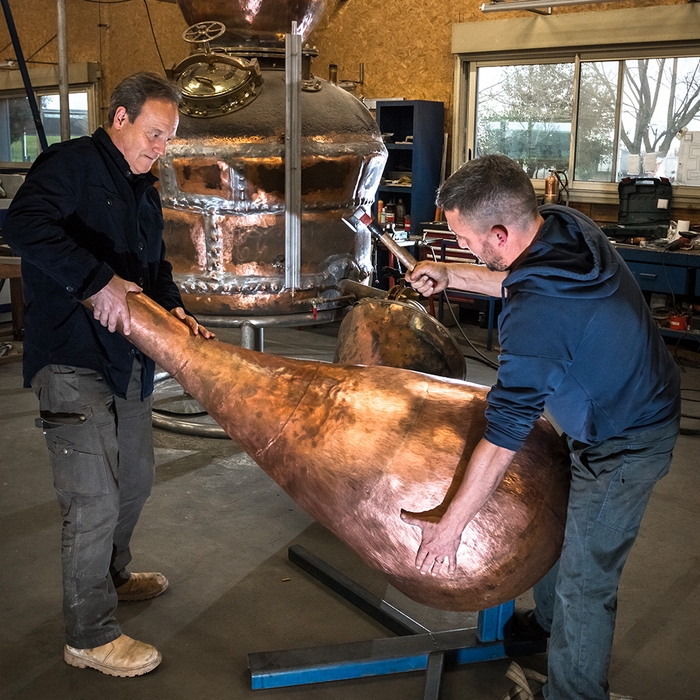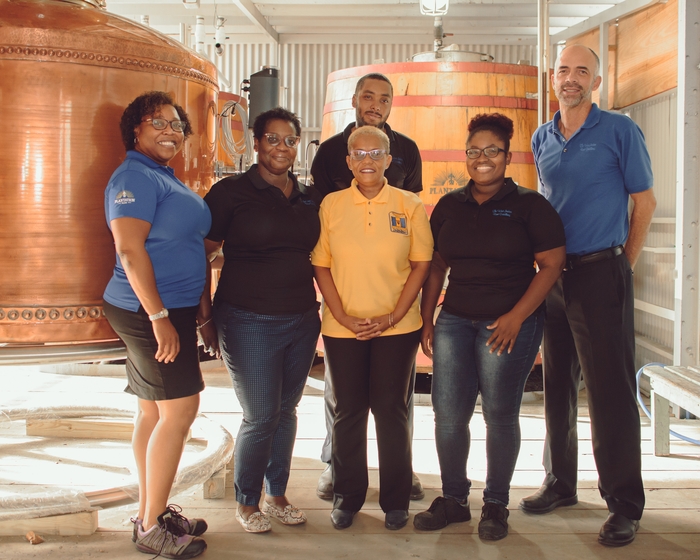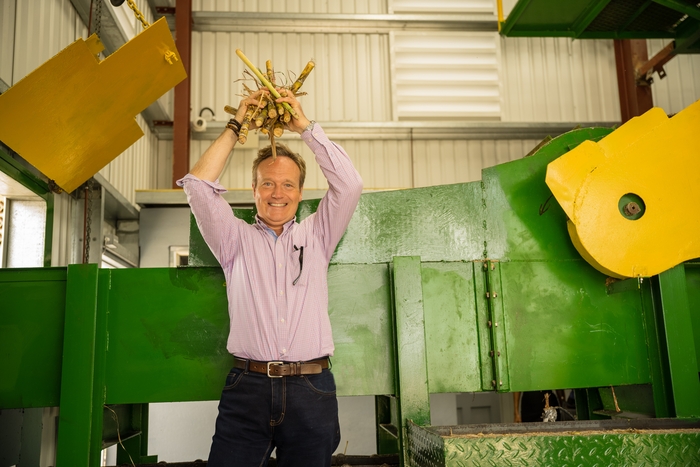
Maison Ferrand, which is at the origin of Plantation Rum, Cognac Ferrand and Citadelle , is led by the ineffable Alexandre Gabriel, a hyperactive enthusiast who added a serious string to his bow in 2017, by acquiring the West Indies Rum Distillery in Barbados, thereby becoming co-owner of National Rums of Jamaica (Long Pond, Clarendon and Innswood). Very quickly, ideas began to flow, especially at WIRD where Alexandre undertook to renovate and create artisanal stills that today allow the distillery to offer a large number of different rum profiles. But this is only a very small part of the projects undertaken recently, as you will see in this interview:
Hello Alexandre, did you have a good Rhum Fest Paris?
Yes, it was a good vintage this year. We saw a lot of people, I was able to do two masterclasses with Martha Miller (CEO of National Rums of Jamaica) and Robert Gordon (Master Blender of Monymusk rums). We brought some pretty crazy little things! (New marks from Clarendon, Long Pond and WIRD, editor's note)
We are taking it easy on Jamaica, because they don't like to show too much. In Barbados, they also have a passionate relationship with their production, they fight over GIs etc., but at the same time they don't necessarily like to talk about what they do. I always tell them: "how do you expect someone to fall in love with who you are, if you don't say who you are?". So we talk about it, and they are gradually opening up. At the same time, I don't decide alone, it's their culture, their heritage. My grandfather always said "you don't own a vineyard or a distillery, you take care of it", so I will never do something against their wishes. We decided together to talk about it a little more, and as enthusiasts they are delighted.
It allows you to taste incredible things. I'm sure you've never tasted a rum with 2600g of esters, since it had never left the country. The fact of being able to do it today is a great first, and I was delighted to do it. Sharing everything I can share, in complete transparency, so that we live the same passion, and taking a lot of people, it's great.
What I remember, even more than this famous mark at 2600g in esters, is the JAWS mark…
JAWS is incredible. It's Barbados at its finest, which is strength and elegance. In Jamaica , you say "ya'mon" when you want to say yes to someone, and in Barbados you say "yes please". You still have that very classy side. At its worst, Barbados rums are too neutral. At its best, it's classy, intense, it doesn't hit you in all directions, it's strength with restraint.
We are already beyond the Wedderburns, since we are in the Light Continental, that is to say in the high esters (700-800 g/hlap). It is a hyper interesting category, which is mastered here and which I love. I was able to understand this culture with the team, and together we created the little miracle that is this new mark. What we tasted had about 6 months of aging, so I let you imagine what it will give with time…
There is also pedigree behind all this: you have Vivian Wisdom, the master distiller from Clarendon who trained Flovia Riley (current production manager), then from New Yarmouth, from Hampden, and who is now with us at WIRD. You could say that he knows Jamaica, fermentation, and he knows how to distill! You also have Dario Jordan, who is really the beast of fermentation. They are good people who decided to work on this with me. Dario and his teams are proud of it: when they do sports competitions in Barbados, sort of cross-country races, they all wear a WIRD or Plantation t-shirt with JAWS written on the back. Everyone wonders why, it's a bit of their password and they have fun with it.
"The other mark is super concentrated, always with Barbadian class"
It's not very accessible if you don't hydrate it, but I thought it was interesting to show it because it was a first. It was Alex Mourigué (France Market Manager) who pushed me to do it, but I thought that someone who wasn't a huge rum fan and who came to the masterclass would completely swim. He told me "that's exactly your challenge!" You know the guys at Ferrand, they like to get everyone on board, and in the end I think people weren't too bored so I was happy.
It’s also good to approach things that we won’t necessarily understand right away, but that we will discover along the way…
Yes, on the other hand there were one or two people in front of me who had tears in their eyes when they drank, but it wasn't from emotion (laughs). It's true that it was a good time, and it opens up horizons. A great spirit is a taste adventure, it's anything but boring, it's a surprise. At Ferrand, I always make this promise to the team: "you'll never get bored!" It's a promise I keep and the Ferrands confirm it: sometimes when you go to sleep at night it's going round in your head but you're never bored (laughs). I think that's also the case for the people who trust us by buying our products, we promise them anything but boredom. It's super important to always take you somewhere.
When I worked with Vivian Wisdom on Canerock , which is an easier rum but which I wanted to be technically very good, we banned anything artificial. It's a Jamaican base, and there is no other expression in herbal infusion, in spiced, that is 100% Jamaican like that. It's an expensive rum base, usually we take a rum from St Croix or Puerto Rico for example. Here, we had a blast making something very stocky but completely accessible. Our only point of disagreement was that he wanted to add a little touch of ganja, in very small quantities, medicinal, but I told him that legally we weren't there yet!
Next year I hope to bring something out of the old Rockley Still, which I teased with a little photo. It is currently in Cognac, but will soon be sailing. We went to sign its shipping box with Martha this week.
Let's talk about this famous Rockley still, is it the one that was once called Shears?
On the still there is a door with the name Shears on it, but the still cannot have been signed by this maker. He was a pretty brilliant coppersmith in the first half of the 19th century. In those pre-industrial days there was a lot of pride in doing things very regularly, and Shears was the French garden of the still. That is not at all the case with this still , which has a dome cast in sand, all rough, really made with hammer blows and rivets.
I asked Dave Wondrich (historian and writer) if he could find any trace of this Rockley, missing the swan neck, with a Shears door etc. One day when he was in London doing some archival research he rang me up like a madman saying he was on a brochure from Shears who actually sold doors for old stills!
“In Cognac, we still don't have doors on our stills, we are still removing the top to load them.”
But in the 19th century, distillers in the Caribbean and Scotland decided that it wasn't practical. It's like getting into your car through the trunk; you can, but after a while you prefer to have a door on the side! So Shears decided to create these doors, which at first posed problems because at the time we didn't have the same quality of seals. They deteriorated with fire and that caused leaks. That's also why we abandoned the idea in Cognac.
We kept this Shears door on the old still, we repolished it by hand, and you can see that it was cast in a much more industrial way than the rest. It is part of the history of this still, and incidentally it is very practical.
"David Pym, the current owner of John Dore, told me it was one of the oldest rum stills in existence."
It seemed thick to him, and he advised me to have it tested. In Cognac , we have all the equipment for this, and I have a boilermaker friend who has a small workshop with four people. They remind me of that TV show where they restore old cars recovered from a barn.
I collect stills, I have about twenty of them. I just bought two small ones from the 19th century, each holding two hectolitres, which arrived all dented. They took them, fixed them up, and it's like the car that comes out of the garage in this show. They're all polished, all spick and span.
The boilermakers spent hundreds of hours on the Rockley. Just to rebuild the elephant trunk, the equivalent of the swan neck, they worked and hammered on it for 300 hours. It seems silly, but at 30 hours a week, that's 10 weeks of hammering on your swan neck!
This still, which was cast in sand, is extremely thick. Today, when you buy a new still, you are around 3mm, and here the dome is still at 9mm, so it has three lives ahead of it. I must not do any high ester acidifications because on the bottom we are more at 3mm, so it is like a new still.
"If you do hyper acid distillations, your still doesn't last more than 15 or 20 years."
I have to do traditional distillations, like in the 18th century, without vinegar, without doing extreme things. It's a machine that will make us great spirits. We hope it will make rum in a few months, in October or November. I have a pretty good idea of what it will give, since I'm used to it, but of course, we can't wait because it will be a great moment. Digger Henderson, who has been at the distillery for 43 years, is very happy to taste it. His father was also a distiller for 47 years, and he knew this still in operation.
I have a book from the end of the 19th century that describes what a rum still is. I found an old Haitian still in it, and Gaylord is ready to make me one from old stills. In this 1898 book from the Bibliothèque de la Revue Générale des Sciences, there is also an "old system" rum still from the beginning of the 19th century, called "elephant's trunk".
David Wondrich sent me some of his research, which shows George Washington's still, which looks a lot like the Rockley. George Washington had two farms: one in the United States, and one in Barbados. The elephant trunk is there too, but it has a technical problem that makes it too close to the capital, so there is a transfer of heat. Scientifically, today, we know that this is stupid, so in my drawings I moved the trunk away from the capital so as not to have this heat contact.
Was Rockley the name of the original manufacturer?
Rockley was the name of a fairly large plantation in the south of the island. I myself have a house in the town of the same name. It is now a golf course, which stretches all the way to the sea. So the name of the still certainly comes from this plantation, although I can't be sure. In any case, it has always been called that locally. We have another still, the Old Gregg, which dates from 1850 and has been distilling for Plantation ever since (which is what attracted me to this distillery), and which we know comes from the farm called Gregg's farm, in the north of the island.
You can see that it is more recent, the rivets are more regular, they were put in with a machine that assembled the plates. It was only later that the embossing system was invented, like car doors, where the parts were shaped with a press. Today, everything is done with a press, so it's a bit crazy to think that you can tap on a part for 300 hours. But it doesn't compress the metal in the same way, it doesn't make stills of the same quality.
“That’s why there are still people who do it by hand, for the ultra purists.”
The Old Gregg still distils, although it leaks everywhere. That's why I'd like Gaylord to come to Barbados . There's work for him, because he's having the Old Gregg repaired, as well as the Vulcan which is still 3mm. We'll use it for another ten years, but we'll have to make a little brother for it. It also leaks a lot, which is not serious in itself, but it costs a stupid amount of energy. So we're going to re-solder it, being very careful. This is called "making a reed", in tin, and you need people who are used to that.
To return one last time to the Rockley, do you have an estimate of its construction date?
Exactly, David Wondrich thinks it's 1780. George Washington's still looks a lot like him, they're almost two brothers. It's even disturbing. But it's not surprising, because at the time, the United States was not thought of from New York to Los Angeles. You have to know that from the 16th to the 18th century, the United States was New England. In South Carolina, the first 11 governors came from Barbados. For all these planters, the two shores were the east of America and the Caribbean. At the time, these islands were the equivalent of Qatar etc.
“We spoke of the sugar barons as we speak of the oil kings today.”
Barbados has a very interesting history. I have a son who has been a history buff for as long as he can remember. When he was 12, he absolutely wanted me to take him to a cemetery in a small village in Barbados because that is where the last Eastern Roman (Byzantine) Emperor is buried. I said to him, "Charles, are you sure you read your book?" Rome, Constantinople and Bridgetown are not the same!
But indeed, there is an old tombstone that dates back to the very beginning of the 17th century, written in Latin. The very last emperor who fought on the ramparts of Constantinople, against the Ottoman Empire, and who died at the end of the 16th century, left the rest to his son. He left for England , then Cromwell took power. The son believed in the legitimacy of royalty, and was therefore against Cromwell, which did not bring him luck. His family being rich, owners of plantations in Barbados, he went to take refuge in this colony, where he died without descendants. His family and his ancestors reigned over the Byzantine Empire, and he appears today on a postage stamp from Barbados. The story is fascinating!
The rest of this interview will be coming soon to the blog!
All illustrations are (c) Maison Ferrand / West Indies Rum Distillery
